|
|
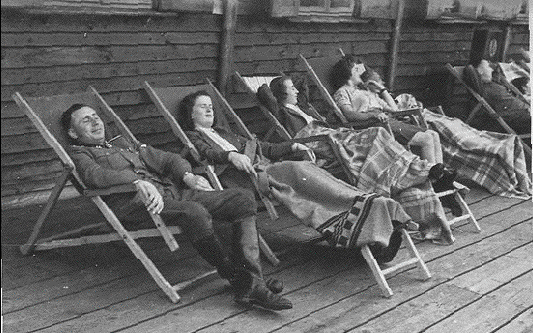
.Between
savagery and killings, savouring the simple pleasures of
life:
Karl
Höcker,
adjutant to the commandant of Auschwitz, and SS
auxiliaries relaxing at a recreation lodge near the
camp.

WASHINGTON, Sept.
18, 2007 -- Last December, Rebecca Erbelding, a young
archivist at the United States Holocaust Memorial Museum,
opened a letter from a former United States Army
intelligence officer who said he wanted to donate
photographs of Auschwitz he had found more than 60 years
ago in Germany.
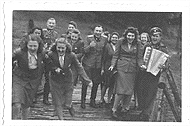
Life
is good at Auschwitz:
The SS guards making time to enjoy
life.

|

Karl
Höcker
|
|
Ms. Erbelding was intrigued: Although
Auschwitz
may be the most notorious of the Nazi death camps, there
are only a small number of known photos of the place
before its liberation in 1945. Some time the next month,
the museum received a package containing 16 cardboard
pages, with photos pasted on both sides, and their
significance quickly became apparent.
As Ms. Erbelding
and other archivists reviewed the album, they realized
they had a scrapbook of sorts of the lives of Auschwitz's
senior SS officers that was maintained by
Karl
Höcker,
the adjutant to the camp commandant. Rather than showing
the men performing their death camp duties, the photos
depicted, among other things, a horde of SS men singing
cheerily to the accompaniment of an accordionist,
Höcker lighting the camp's Christmas tree, a cadre
of young SS women frolicking and officers relaxing, some
with tunics shed, for a smoking break.
In all there are
116 pictures, beginning with a photo from June 21, 1944,
of Höcker and the commandant of the camp, Richard
Baer, both in full SS regalia. The album also contains
eight photos of Josef
Mengele,
the camp doctor notorious for participating in the
selections of arriving prisoners and bizarre and cruel
medical experiments. These are the first authenticated
pictures of Mengele at Auschwitz, officials at the
Holocaust museum said.
The photos provide
a stunning counterpoint to what up until now has been the
only major source of preliberation Auschwitz photos, the
so-called Auschwitz Album, a compilation of pictures
taken by SS photographers in the spring of 1944 and
discovered by a survivor in another camp. Those photos
depict the arrival at the camp of a transport of
Hungarian Jews, who at the time made up the last
remaining sizable Jewish community in Europe. The
Auschwitz Album, owned by Yad Vashem, the Israeli
Holocaust museum, depicts the railside selection process
at Birkenau, the area where trains arrived at the camp,
as SS men herded new prisoners into lines.

.Left
to right: Dr. Josef Mengele, Rudolf Höss, Josef Kramer,
and an unidentified officer.
[United States Holocaust Memorial Museum #34755]
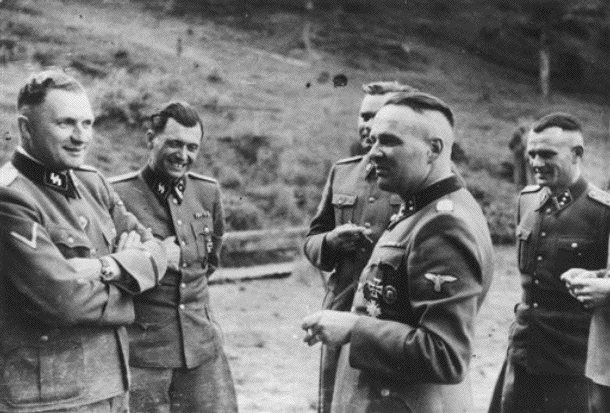
|
.Members
of the "Master Race" relax at their retreat at
Solahutte outside of Auschwitz.
From
left: Richard Baer, who became the commandant of
Auschwitz in May 1944;
Dr. Josef Mengele; Josef Kramer
(hidden), Commandant of Auschwitz-Birkenau;
and,
Rudolf Hoess (foreground), the former Commandant of
Auschwitz; with the man at right
unidentified.
|
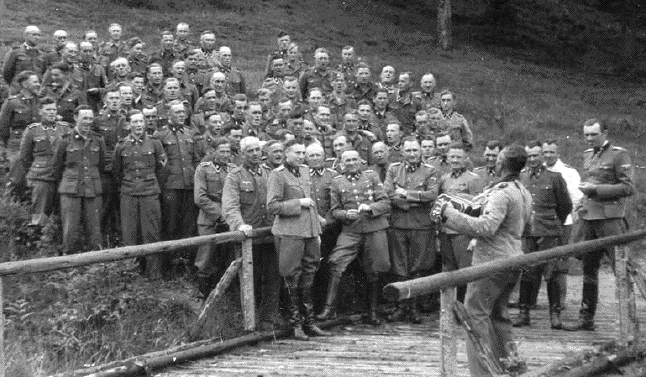
.Taking
a break from savagery and killings, SS Officers are in the
mood to sing:
An
accordionist leads a sing-along for SS officers at their
retreat at Solahutte outside
Auschwitz.
Pictured in the front row are Karl Hoecker, Otto Moll,
Rudolf Hoess, Richard Baer, Josef Karmer, Franz Hoessler,
and Dr. Josef Mengele.
[United States Holocaust Memorial Museum]
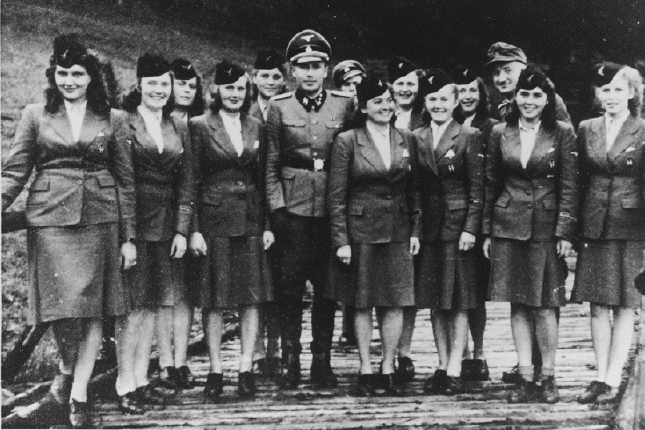
.All
smiles:
Members
of the SS Helferinnen (female auxiliaries) arrive in
Solahuette, the SS retreat near Auschwitz.
(Karl Hoecker is standing in the center.)
[United
States Holocaust Memorial Museum #34762]]
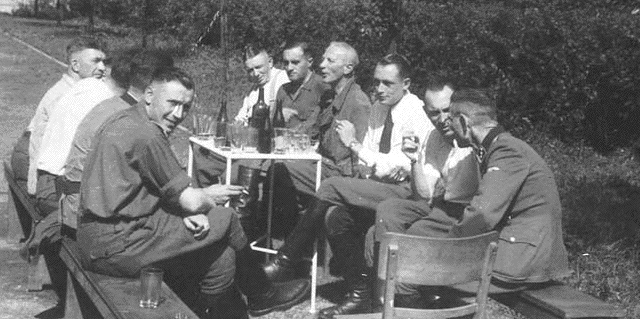
.Karl
Höcker (on left, looking at the camera) relaxes with SS
physicians,
including Dr. Fritz Klein (far left), Dr. Horst Schumann
(partially obscured next to Klein, identified from other
photographs),
and Dr.
Eduard Wirths
(third from right, wearing
tie).
[United
States Holocaust Memorial Museum
#34797]
The
comparisons between the albums are both poignant and
obvious, as they juxtapose the comfortable daily lives of
the guards with the horrific reality within the camp,
where thousands were starving and 1.1 million
died.
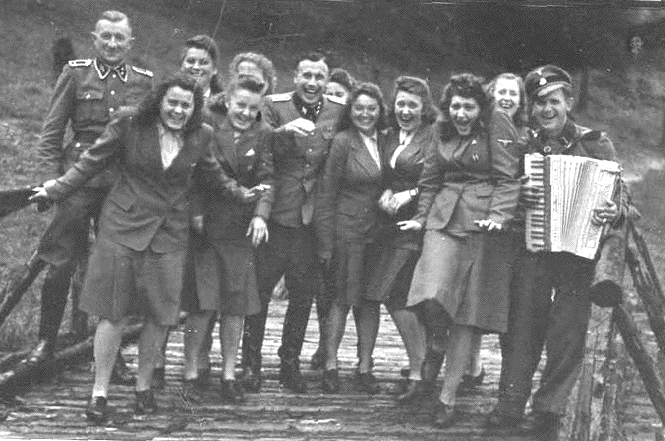
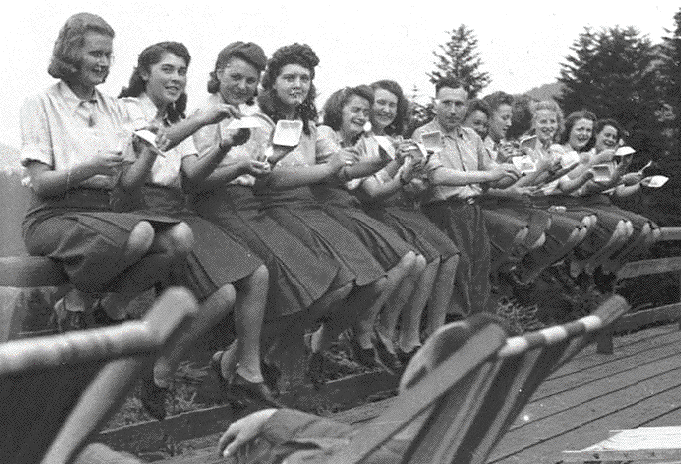
Life is good at Auschwitz: All smiles.
The SS female auxiliaries (Helferinnen) show with mock
sadness that they have finished eating their blueberries,
July 22, 1944.
[United
States Holocaust Memorial Museum
#34769]
For example, one of
the Höcker pictures, shot on July 22, 1944, shows a
group of cheerful young women who worked as SS
communications specialists eating bowls of fresh
blueberries. One turns her bowl upside down and makes a
mock frown because she has finished her
portion.
On that day, said
Judith Cohen, a historian at the Holocaust museum in
Washington, 150 new prisoners arrived at the Birkenau
site. Of that group, 21 men and 12 women were selected
for work, the rest transported immediately to the gas
chambers.
Those killings were
part of the final frenetic efforts of the Nazis to
eliminate the Jews of Europe and others deemed
undesirable as the war neared its end. That summer the
crematoriums broke down from overuse and some bodies had
to be burned in open pits. A separate but small group of
known preliberation photos were taken clandestinely of
those burnings.
Auschwitz was
abandoned and evacuated on Jan. 18, 1945, and liberated
by Soviet forces on Jan. 27. Many of the Höcker
photos were taken at Solahütte, an Alpine-style
recreation lodge the SS used on the far reaches of the
camp complex alongside the Sola River.
Though they as yet
have no plans to exhibit the Höcker album photos,
curators at the Holocaust Memorial Museum have created an
online display of them on the museum's Web site
(ushmm.org) that will be available this week. In many
cases they have contrasted the Höcker images with
those from the Auschwitz Album. In one, SS women alight
from a bus at Solahütte for a day of recreation;
meanwhile, in a picture from the Auschwitz Album taken at
about the same time, haggard and travel-weary women and
children get off a cattle car at the camp.
Museum curators
have avoided describing the album as something like
"monsters at play" or "killers at their leisure." Ms.
Cohen said the photos were instructive in that they
showed the murderers were, in some sense, people who also
behaved as ordinary human beings. "In their self-image,
they were good men, good comrades, even civilized," she
said.
Sarah J.
Bloomfield, the museum's director, said she believed that
other undiscovered caches of photos or documents
concerning the Holocaust existed in attics and might soon
be lost to history.
The donor, who had
asked to remain anonymous, was in his 90s when he
contacted the museum, and he died this summer. He told
the museum's curators that he found the photo album in a
Frankfurt apartment where he lived in
1946.
The photos of the
Auschwitz Album were discovered by Lili Jacob, a
Hungarian Jew who was deported in May 1944 to Auschwitz,
near Krakow in Poland. She was transferred to another
camp, Dora-Mittelbau in Germany, where she discovered the
pictures in a bedside table in an abandoned SS
barracks.
She was stunned to
recognize pictures of herself, her rabbi and her brothers
aged 9 and 11, both of whom she later discovered had been
gassed immediately after arrival.
Höcker fled
Auschwitz before the camp's liberation. When he was
captured by the British he was carrying false documents
identifying him as a combat soldier. After the 1961 trial
of Adolf Eichmann in Israel, West German authorities
tracked down Höcker in Engershausen, his hometown,
where he was working as a bank official.
He was convicted of
war crimes and served seven years before his release in
1970, after which he was rehired by the bank. Höcker
died in 2000 at 89.

Copyright 2007
The New York Times Company
|
|